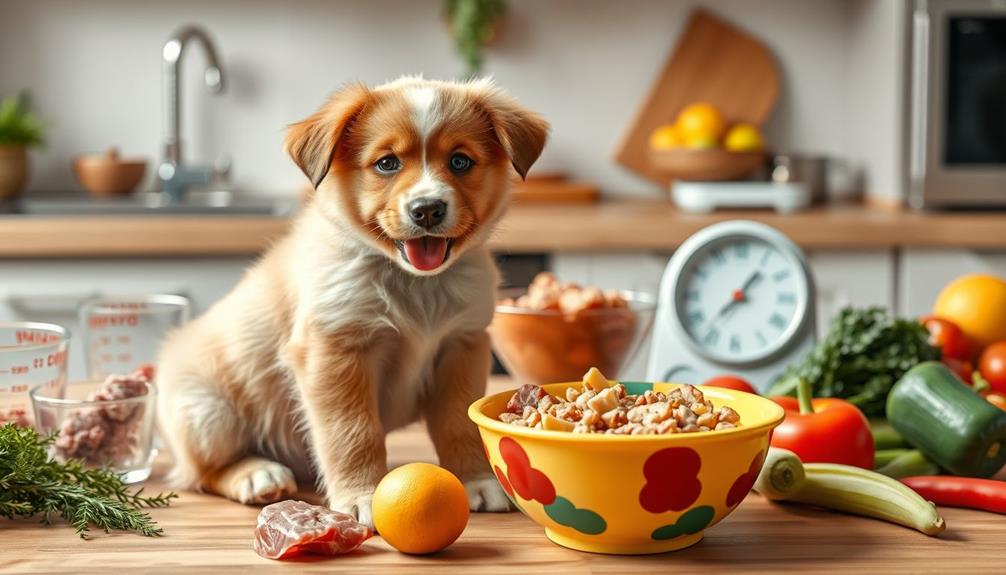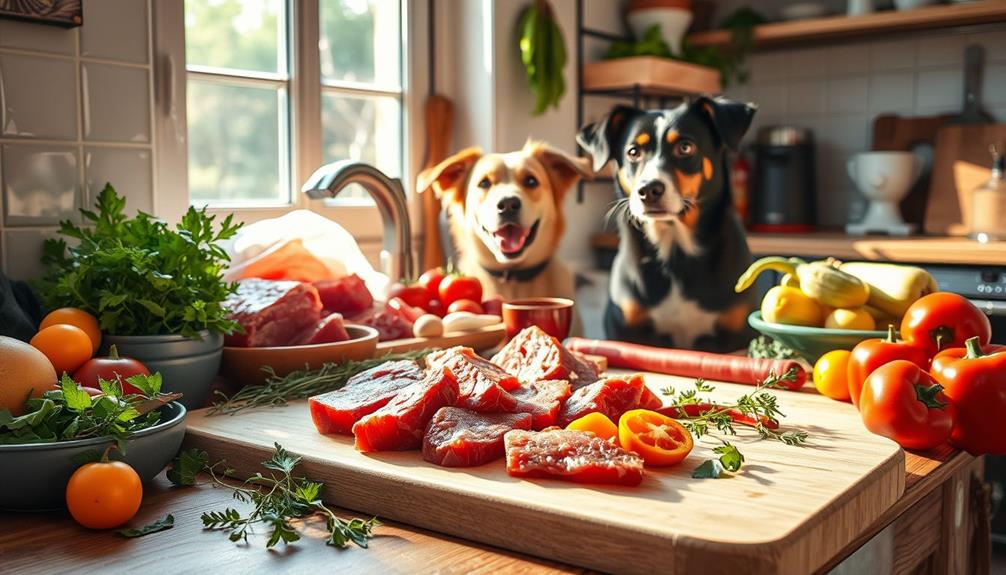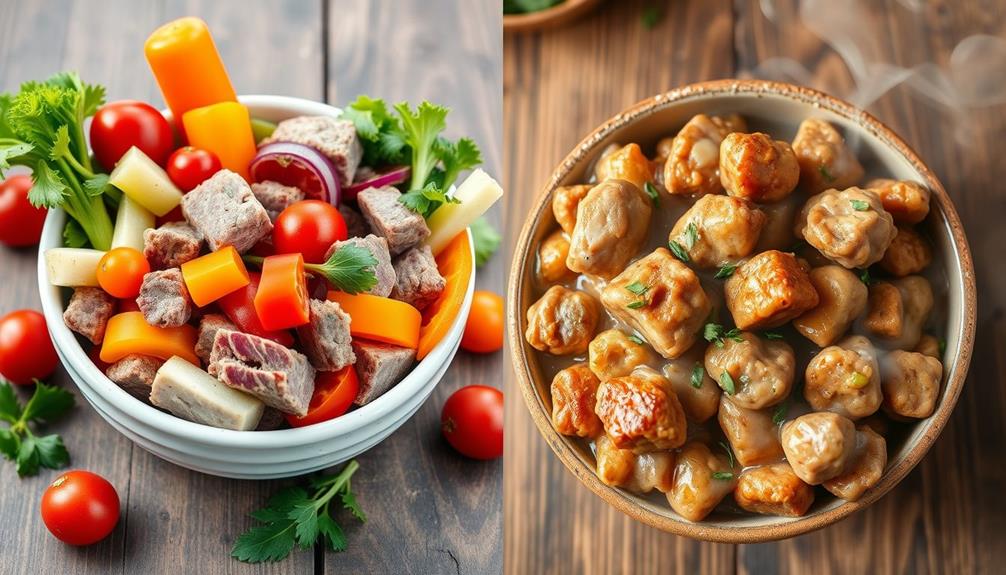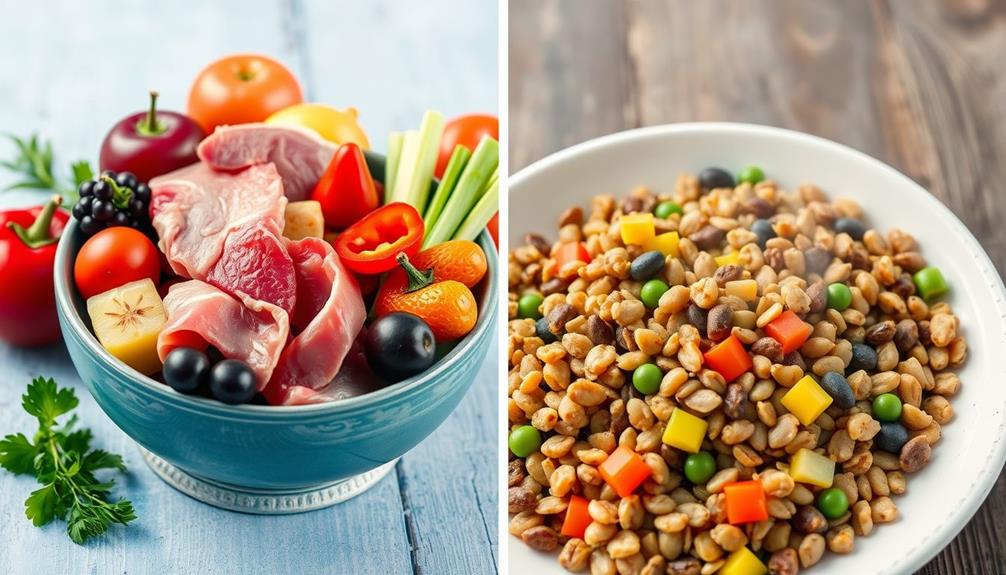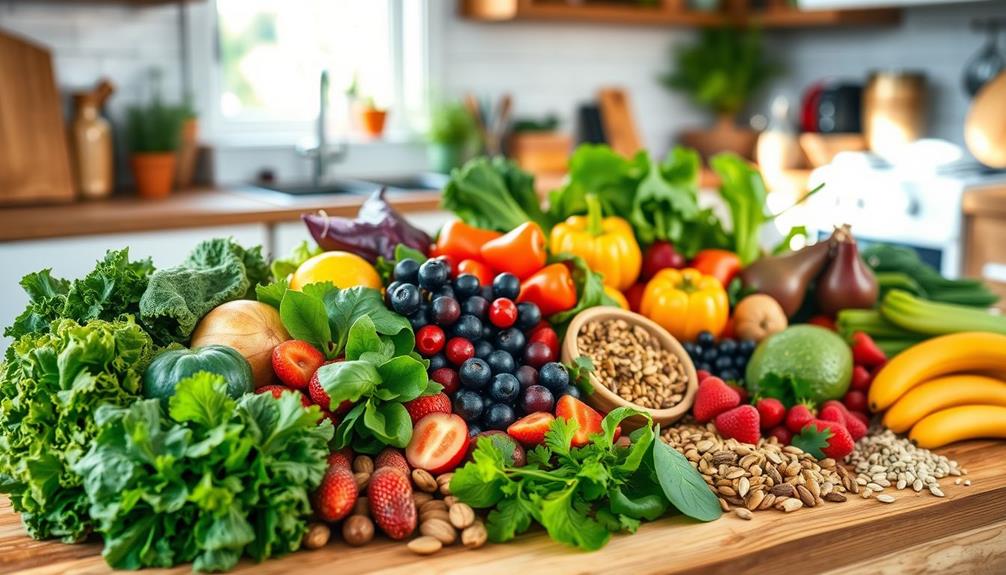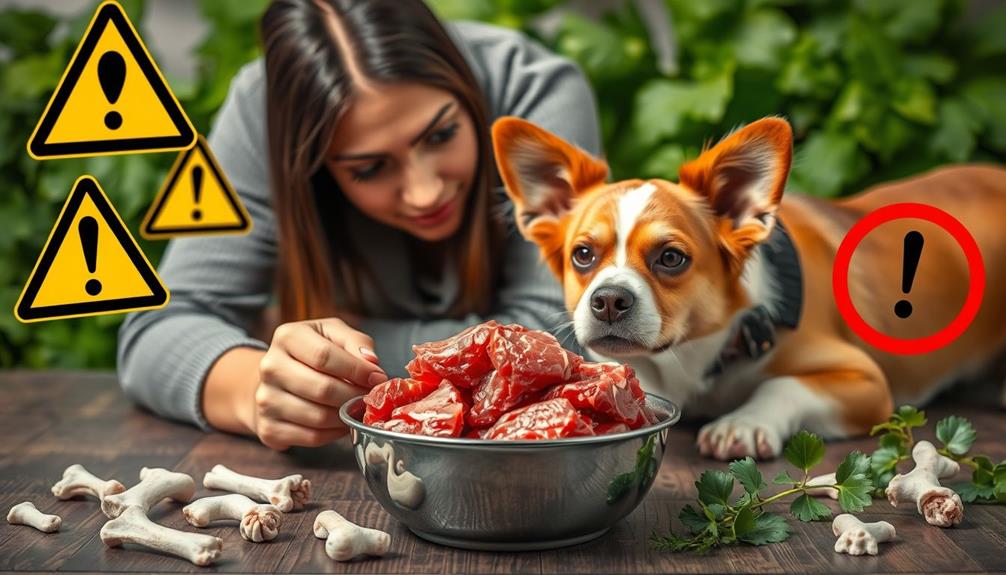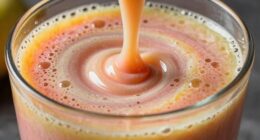When feeding your puppy raw food, aim for 5-10% of their body weight daily. For puppies under six months, you should feed around 8% at 3-4 weeks, gradually reducing to 5% by six months. It's best to divide their meals into smaller portions, with four meals a day until 12 weeks, then shifting to two meals by 16-18 weeks. Using a raw food calculator can help you adjust portions based on their growth and weight changes. Stick with it, and you'll find the right balance for your puppy's dietary needs and health, with more tips just ahead.
Key Takeaways
- Puppies aged 0-3 weeks should only receive mother's milk; raw food introduction begins at 3-4 weeks at approximately 8% of body weight daily.
- From 6 to 12 weeks, feed puppies about 5-10% of their body weight in raw food daily, adjusting as they grow.
- Use a Raw Food Calculator to determine accurate feeding amounts based on the puppy's current weight and age.
- Regularly monitor your puppy's weight weekly and adjust food intake to limit weight loss to no more than 1-2% per week.
- Breed-specific guidelines recommend varying daily intake; larger breeds may require significantly more raw food than smaller breeds.
Understanding Raw Food Requirements
Understanding your puppy's raw food requirements is vital for their healthy development. Proper nutrition is key during this growth phase, as it sets the foundation for lifelong health. You need to guarantee your furry friend gets the right amount of food based on their age and weight. A raw food calculator can help you determine the exact amount of food needed.
For very young puppies aged 0-3 weeks, mother's milk is all they should consume. As they grow and reach 3-4 weeks, you should start feeding them about 8% of their body weight daily.
As your puppy matures, the percentage of food required decreases. By six months, you'll want to feed them around 5% of their body weight. It's important to regularly monitor your puppy's growth and adjust their food intake accordingly.
Keep in mind that feeding frequency also changes; you'll start with four meals per day, reducing to three at 12 weeks and eventually to two meals by 16-18 weeks. Additionally, be mindful of the shift to adult food around 12 months, as their energy needs change.
Daily Feeding Amounts for Puppies
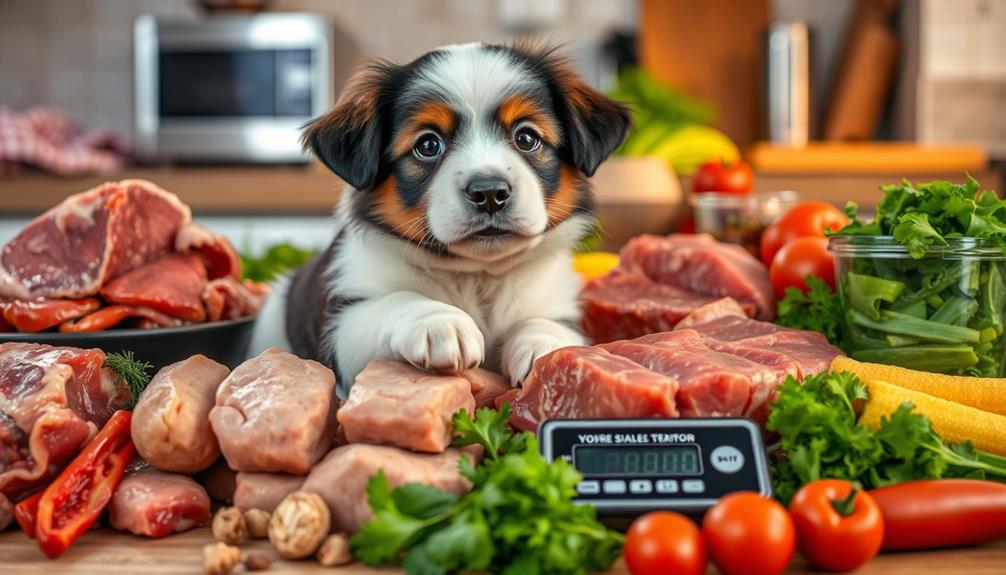
Feeding your puppy the right daily amount of raw food is key to supporting their growth and energy needs. Puppies generally require 5-10% of their body weight in raw food daily, but this amount decreases to about 5% by the time they reach six months.
For very young puppies aged 0-3 weeks, their only nutrition should come from their mother's milk. Once they hit 3-4 weeks, you should start feeding them approximately 8% of their body weight daily. It's important to choose high-quality ingredients, similar to what's recommended in the Ultimate Hamster Care Guide, to guarantee your puppy receives balanced nutrition.
As your puppy grows, they'll need four meals a day until they're 12 weeks old. After that, you can shift to three meals daily.
It's important to keep an eye on your puppy's weight and adjust the amount of raw food accordingly. This regular monitoring helps confirm they're getting the right daily portion necessary for ideal growth and health.
Using the Raw Food Calculator

To get the right amount of raw food for your puppy, start by inputting their current weight into the Raw Food Calculator.
This tool uses age-based feeding percentages to guide you, ensuring your puppy gets the right nutrition as they grow.
Additionally, understanding your puppy's budgeting for pet care can help you manage the costs associated with a raw food diet.
Plus, it helps you adjust their intake as their needs change, making the shift to a raw diet easier.
Inputting Puppy Weight
Calculating the right amount of raw food for your puppy starts with knowing its current weight. This is vital because the raw food calculator uses this information to generate personalized feeding recommendations tailored to your puppy's needs.
Typically, puppies require about 5-10% of their body weight in raw food daily, but this percentage will decrease to around 5% as they reach six months of age. It's important to remember that just like human children, puppies experience various stages of growth, influenced by biological and environmental factors, which can affect their nutritional needs key domains of development.
When you input your puppy's weight into the calculator, it will provide you with a specific amount of food to feed daily. This guarantees your furry friend receives the right nutrition for growth and development.
It's crucial to regularly monitor your puppy's weight and adjust the food portions based on the calculator's suggestions. Doing so helps maintain healthy growth and prevents obesity, which can lead to other health issues.
Age-Based Feeding Percentages
Understanding your puppy's age helps refine the feeding percentages recommended by the Raw Food Calculator. For very young puppies aged 0-3 weeks, you should only provide mother's milk, as their nutritional needs are met through it.
As they reach 3-4 weeks, it's time to introduce raw food, feeding them approximately 8% of their body weight daily. This percentage is vital, as it supports their rapid growth and helps to guarantee they receive the essential nutrients needed for proper development. Additionally, considering natural remedies can be beneficial in supporting your puppy's health during their early stages.
As your puppy continues to grow, their raw food intake should adjust. By six months, the recommended amount decreases to around 5% of their body weight. This change is significant for maintaining a healthy growth rate without overfeeding.
The Raw Food Calculator can be your best ally in determining the exact amount needed based on your puppy's current weight and age. Regularly monitor your puppy's weight to make certain these feeding percentages remain appropriate. Utilizing a raw food feeding calculator ensures that your puppy is receiving the correct balance of nutrients for their growth and development. By inputting their weight and age, the calculator can provide you with precise guidelines on how much to feed them. It takes the guesswork out of meal planning and helps keep your puppy at a healthy weight.
This ongoing observation is key to their ideal health and development. By using the raw food calculator and adjusting based on age, you'll help your puppy thrive as they evolve towards adulthood.
Adjusting for Growth Needs
As your puppy grows, adjusting their raw food intake becomes vital to meet their changing nutritional needs. Puppies generally require 5-10% of their body weight in raw food daily, decreasing to around 5% by six months. Using a Raw Food Calculator can help you determine the right amount based on your puppy's weight and growth stage.
Monitoring your puppy's weight regularly is significant to guarantee they're getting the right amount of food for ideal growth. As they mature, the frequency of meals will also change—from four meals daily for very young puppies to two meals by 16-18 weeks of age.
Here's a simple guide to help you adjust their raw food intake:
| Puppy Age | Daily Raw Food Intake (%) | Meal Frequency |
|---|---|---|
| 0-8 weeks | 10% | 4 meals |
| 8-16 weeks | 8% | 4 meals |
| 16-24 weeks | 6% | 3 meals |
| 6 months – 1 year | 5% | 2 meals |
| 12 months+ | Change to adult food | 2 meals |
Keep using the calculator to guarantee your puppy thrives!
Nutritional Needs by Age
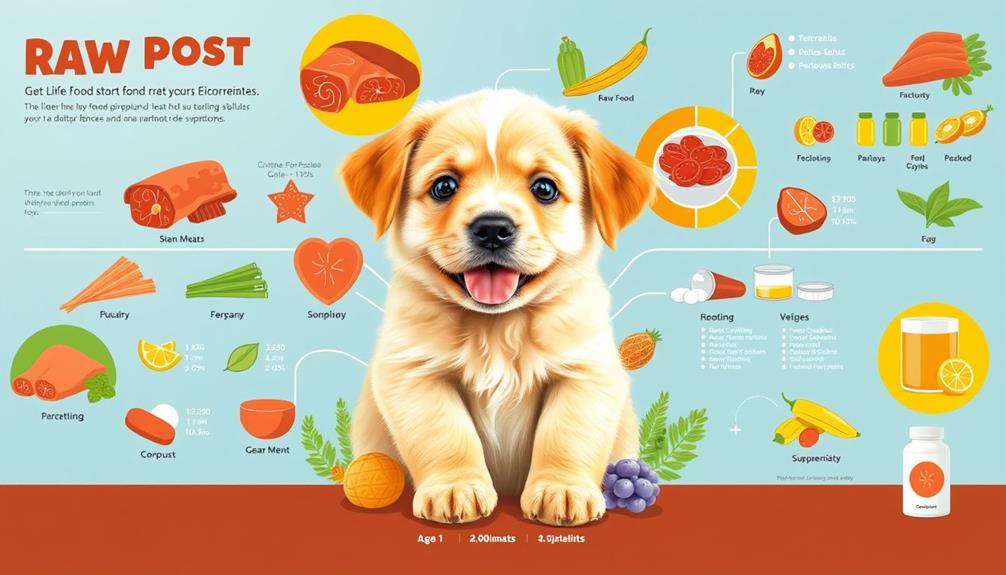
As your puppy grows, their nutritional needs change notably, so it's important to adjust their raw food intake accordingly.
Feeding them a balanced diet with natural ingredients is essential for their development and overall health.
You'll start by feeding them 5-10% of their body weight daily, but this amount will decrease as they reach six months.
Understanding these changes guarantees your pup gets the right nutrients at every stage of their development.
Feeding Amounts by Age
Puppies need a carefully balanced diet that evolves as they grow, with feeding amounts based on their age and weight.
In their early weeks, from 0 to 3 weeks, they should only consume mother's milk.
At around 3 to 4 weeks, begin changing to solid food, gradually introducing raw food options.
It's vital to guarantee the raw food is safe and suitable for their sensitive digestive systems, similar to how piercing care and hygiene are important for preventing complications.
From 6 to 12 weeks, you'll want to feed your puppy about 5-10% of their body weight in raw food daily.
Monitor their growth closely during this stage; adjust the amounts accordingly to meet their developmental needs.
Nutritional Requirements Overview
Feeding a puppy goes beyond just amounts; understanding their nutritional requirements is key to supporting their growth and development. Puppies need specific nutrients at different ages to thrive, especially when shifting to raw food. Here's a quick overview of their nutritional needs:
| Age (Weeks) | Daily Intake (of Body Weight) |
|---|---|
| 0-3 | Mother's milk only |
| 3-4 | Approximately 8% |
| 4-12 | 5-10% |
| 12-24 | Decrease to 5% |
| 12+ (Adult) | Change to adult food |
For very young puppies (0-3 weeks), only mother's milk is recommended. As they grow to 3-4 weeks, they require about 8% of their body weight in raw food daily. You'll notice that the amount decreases to around 5% by six months. Feeding frequency also changes; start with four meals daily and reduce to two meals by 16-18 weeks. Regularly monitor your puppy's weight and growth to make sure they're getting the proper nutrition to support their development.
Transitioning to Adult Dog Food
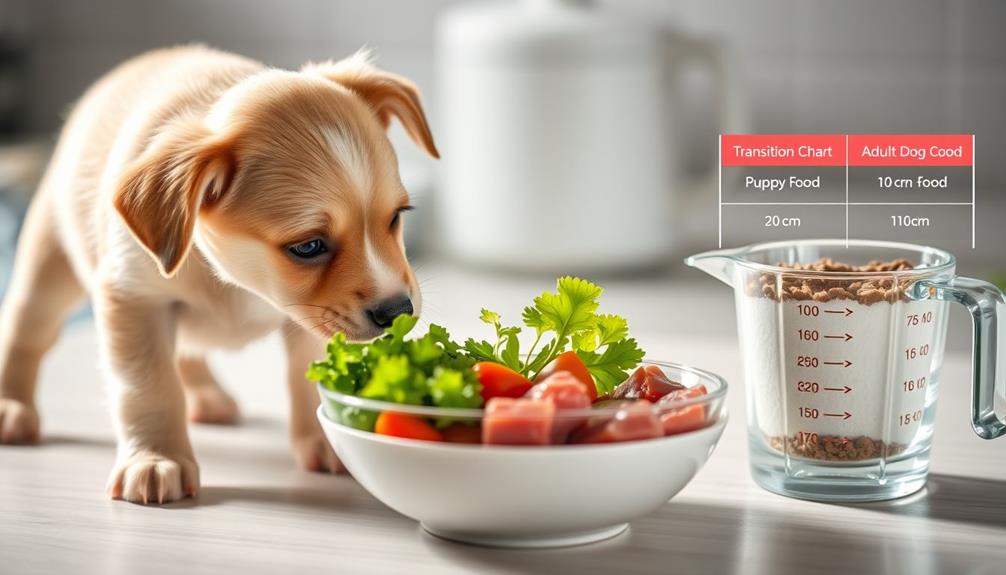
Shifting your puppy to adult dog food is a significant milestone that comes around 12 months of age, when their nutritional needs alter.
As your puppy matures, it's essential to adjust their diet to maintain a healthy body weight and overall condition. Understanding the importance of long-term financial planning for pet care can also be beneficial.
Here are some steps to help you with the changeover process:
- Gradual Mixing: Over the course of a week, mix adult dog food with the puppy food, increasing the adult food ratio daily. This helps minimize digestive upset.
- Monitor Weight: Keep a close eye on your puppy's growth and body weight during this change. Ideally, adult dogs should eat about 2-3% of their body weight daily, compared to the 5-10% they needed as puppies.
- Veterinary Consultation: Talk to your veterinarian to determine the best adult dog food for your pet's breed, size, and activity level.
- Regular Feeding Schedule: Establish a consistent feeding schedule to help your dog adapt to their new diet and maintain a healthy routine.
Following these steps will guarantee a smooth changeover to adult dog food, supporting your pet's health and well-being.
Benefits of a Raw Diet
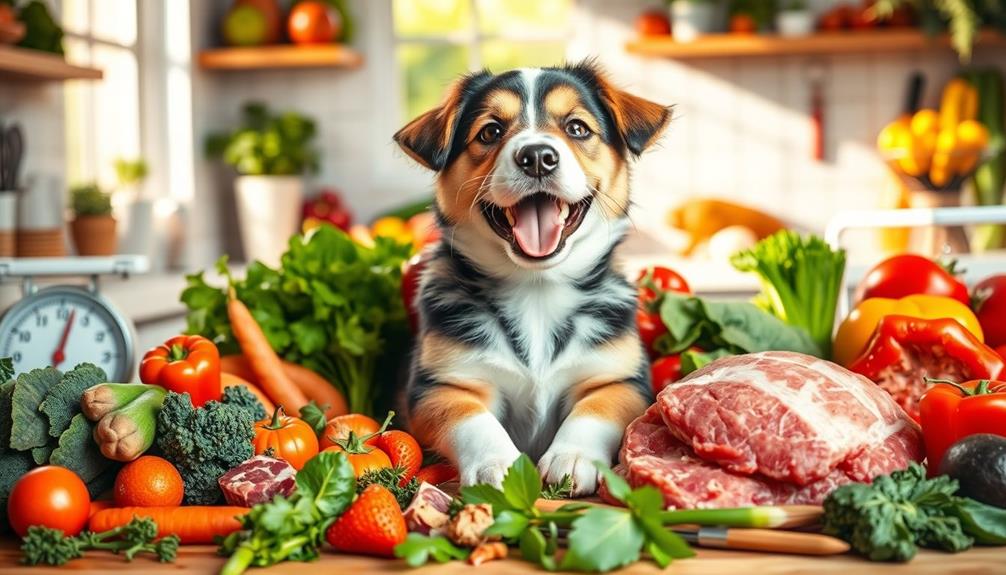
Feeding your puppy a raw diet can lead to improved health outcomes and enhanced digestive function. Many owners notice firmer stools and better overall digestion after making the switch.
Additionally, incorporating a variety of nutrients, including essential fatty acids, can further support your puppy's immune system and energy levels. By tailoring their nutrition to your puppy's specific needs, you support their growth and vigor during this essential stage.
essential oils for health can also be beneficial in promoting overall well-being.
Improved Health Outcomes
Opting for a raw diet can lead to remarkable health benefits for your puppy. Many owners notice significant improvements once they switch to this type of food.
Here are some key benefits you can expect:
- Improved Stool Quality: Puppies on a raw diet often produce firmer and smaller stools, making clean-up easier. This can be similar to the benefits observed in other dietary changes, such as improved digestive health in humans, as noted with celery juice benefits.
- Better Weight Management: A raw diet supports healthy growth and development, helping your puppy maintain an ideal weight.
- Enhanced Nutritional Value: Raw food provides essential vitamins and minerals vital for your puppy's overall health and development.
- Increased Energy Levels and Better Coat Condition: Many pet owners report that their puppies become more energetic and have shinier coats after adapting to a raw food diet.
Enhanced Digestive Function
A raw diet can greatly enhance your puppy's digestive function, leading to improved overall health. When you choose raw feeding, you're opting for a diet that's easier for your puppy to digest compared to processed foods. This often results in smaller, firmer stools, a sign that your puppy's system is efficiently processing what they eat.
Additionally, using essential oils for skin conditions can complement the benefits of a raw diet by promoting healthy skin and coat.
The natural enzymes and probiotics in raw food greatly boost nutrient absorption, which is essential for your puppy's growth and development. You may notice fewer gastrointestinal issues, like bloating and gas, when switching to a raw diet. This is largely due to the balanced mix of muscle meat, bones, and organs that provide necessary proteins, fats, and vitamins, all supporting digestive health.
Puppies on a raw diet typically show increased energy levels and overall liveliness. This improvement stems from better nutrient utilization and enhanced gut health, allowing your puppy to thrive.
Monitoring Weight and Adjustments
Monitoring your puppy's weight is essential for ensuring they're receiving the right amount of raw food. Regularly checking their weight helps you make necessary adjustments to their diet, which is vital during their early growth stages.
Typically, puppies should consume 5-10% of their body weight daily, and tracking this can prevent issues.
Here's how to effectively monitor and adjust your puppy's feeding:
- Weigh Weekly: Check your puppy's weight at least once a week to monitor growth accurately.
- Use a Puppy Food Calculator: This tool can help you determine the right food portions based on your puppy's current weight and age.
- Adjust Portions: If your puppy is gaining too much weight, decrease their food intake. Conversely, if they're underweight, increase their portions.
- Limit Weight Changes: Aim for a weight loss of no more than 1-2% per week, ensuring healthy adjustments without compromising growth.
Breed-Specific Feeding Guidelines

When it comes to feeding your puppy, understanding breed-specific guidelines is essential for their health and growth. Each breed has unique nutritional needs, which can greatly impact their development. For example, larger breeds like the American Bulldog need more raw food compared to smaller breeds like the Affenhuahua.
Here's a quick reference table to help you:
| Breed | Daily Raw Food Amount |
|---|---|
| Afador | 460g to 680g |
| Affenhuahua | 40g to 100g |
| American Bulldog | 540g to 1080g |
Puppies typically require 5-10% of their body weight in raw food daily, with the amount decreasing to around 5% by six months of age. It's vital to adjust their food intake regularly based on their age, weight, and breed-specific requirements. As your puppy matures, moving to adult food around 12 months will help accommodate their shifting energy needs. By following these breed-specific feeding guidelines, you'll guarantee your puppy receives the right amount of raw food for ideal health and development.
Cost Considerations for Raw Feeding
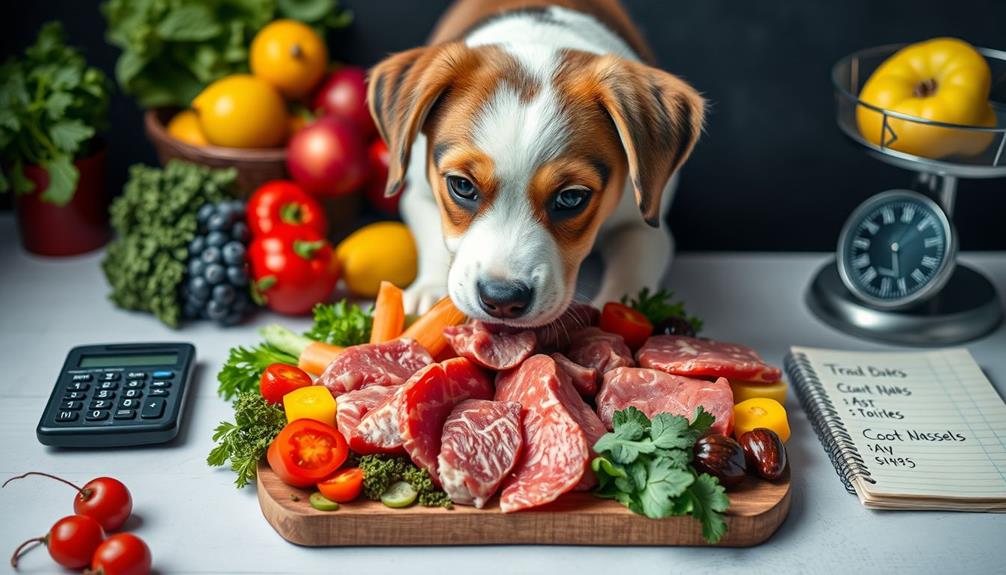
Feeding your puppy a raw diet can be a rewarding choice, but it's important to take into account the costs involved. The price of raw food varies considerably depending on your puppy's breed size and daily intake. For instance, smaller breeds might cost around £0.17 to £0.43 per day, while larger breeds can set you back up to £4.30 to £7.83 daily.
Here are some cost considerations to keep in mind:
- Daily Intake: Puppies need 5-10% of their body weight in raw food, leading to fluctuating monthly expenses as they grow.
- Bulk Purchases: Buying larger quantities can lower the per kilo price, making it more economical.
- Weight Monitoring: Regularly check your puppy's weight and adjust portions to manage costs while ensuring proper nutrition.
- Supplements: Budget for additional vitamins and minerals to meet your puppy's nutritional needs, as a raw diet may require extras.
Tips for Successful Raw Feeding
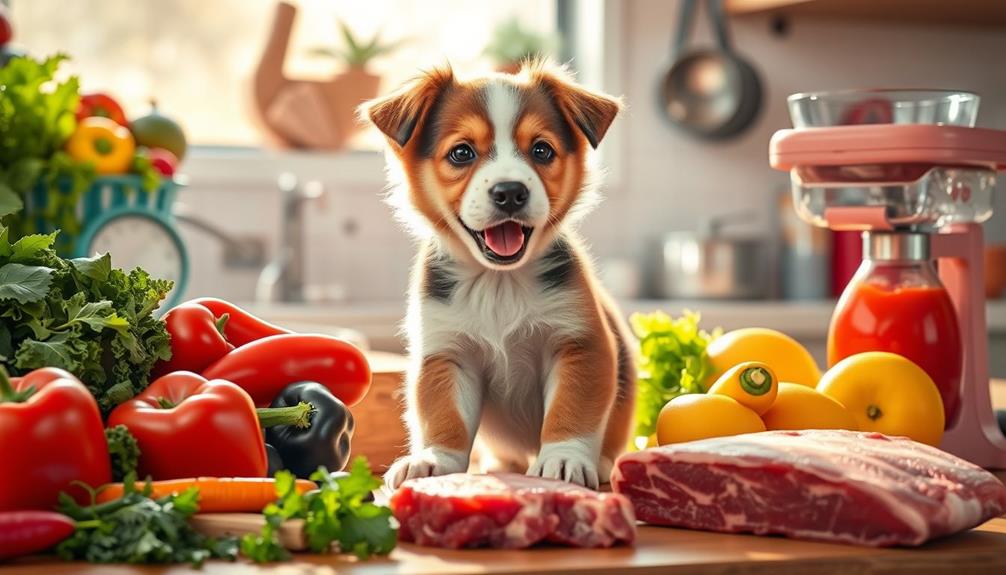
Successfully feeding your puppy a raw diet requires careful planning and attention to detail. Start by determining your puppy's daily food intake, which is typically 5-10% of their body weight. You can use a raw dog food calculator to help you find the right amount.
For young puppies, ages 0-3 weeks, mother's milk is essential, while those aged 3-4 weeks can begin eating about 8% of their body weight daily.
Feeding frequency is also important. Very young puppies should be fed four meals a day, gradually reducing to two meals by 16-18 weeks. This structure helps meet their growing needs.
As your puppy approaches six months, decrease their food intake to around 5% of body weight to align with their changing nutritional requirements.
Keep a close eye on your puppy's weight and growth throughout this process. Monitoring guarantees they receive the right amount of food for peak development.
Frequently Asked Questions
How Much Raw Food to Feed a Puppy per Day Calculator?
To determine how much raw food to feed your puppy daily, input their weight and age into a puppy food calculator. This guarantees you're meeting their nutritional needs as they grow and develop.
How Do You Calculate Raw Dog Food Portions?
Calculating raw dog food portions is like solving a delicious puzzle! You'll want to start with your dog's weight, feeding them about 5-10% daily. Adjust as they grow, ensuring they thrive and wag their tails!
How Much to Feed a Puppy Chart Calculator?
To determine your puppy's food intake, use a feeding calculator that considers their weight and age. It'll guide you in adjusting portions as they grow, ensuring they're healthy and developing properly. Regular checks are essential!
How Much Do I Feed My Puppy Chart?
If you have a 10 kg puppy, you'd feed them 500-1,000 g of food daily. To figure out how much to feed your puppy, consult a feeding chart that considers their age and weight.
Conclusion
Feeding your puppy raw food can feel overwhelming, yet it's a rewarding journey that fuels their growth. Balancing their nutritional needs while keeping an eye on their weight is essential, but with the right guidance, you can navigate this path with confidence. Remember, shifting to adult food doesn't mean abandoning the raw principles; it's about adapting. Embrace the challenge, and you'll witness the vibrant energy and health your puppy will gain from a well-planned raw diet.

